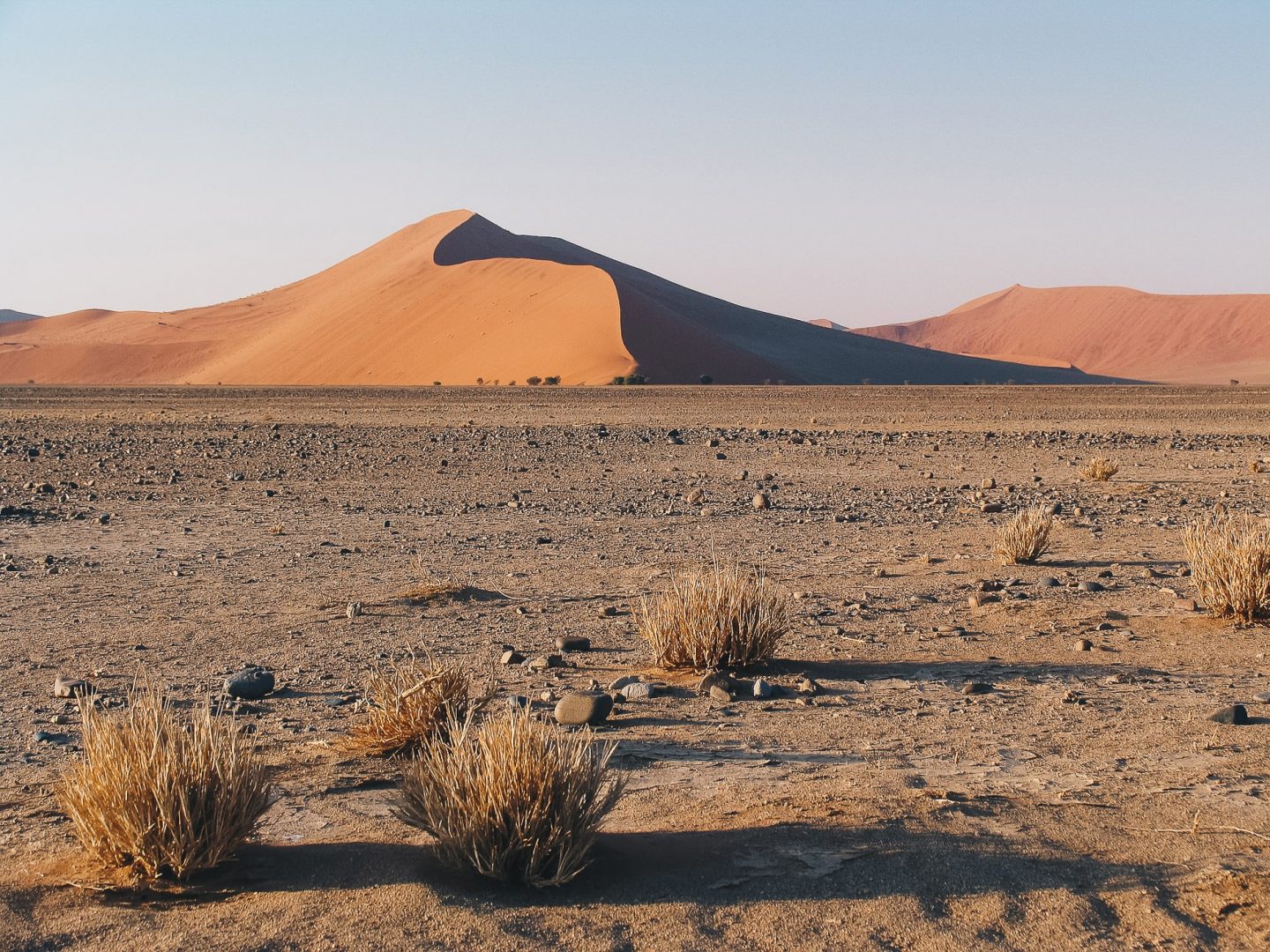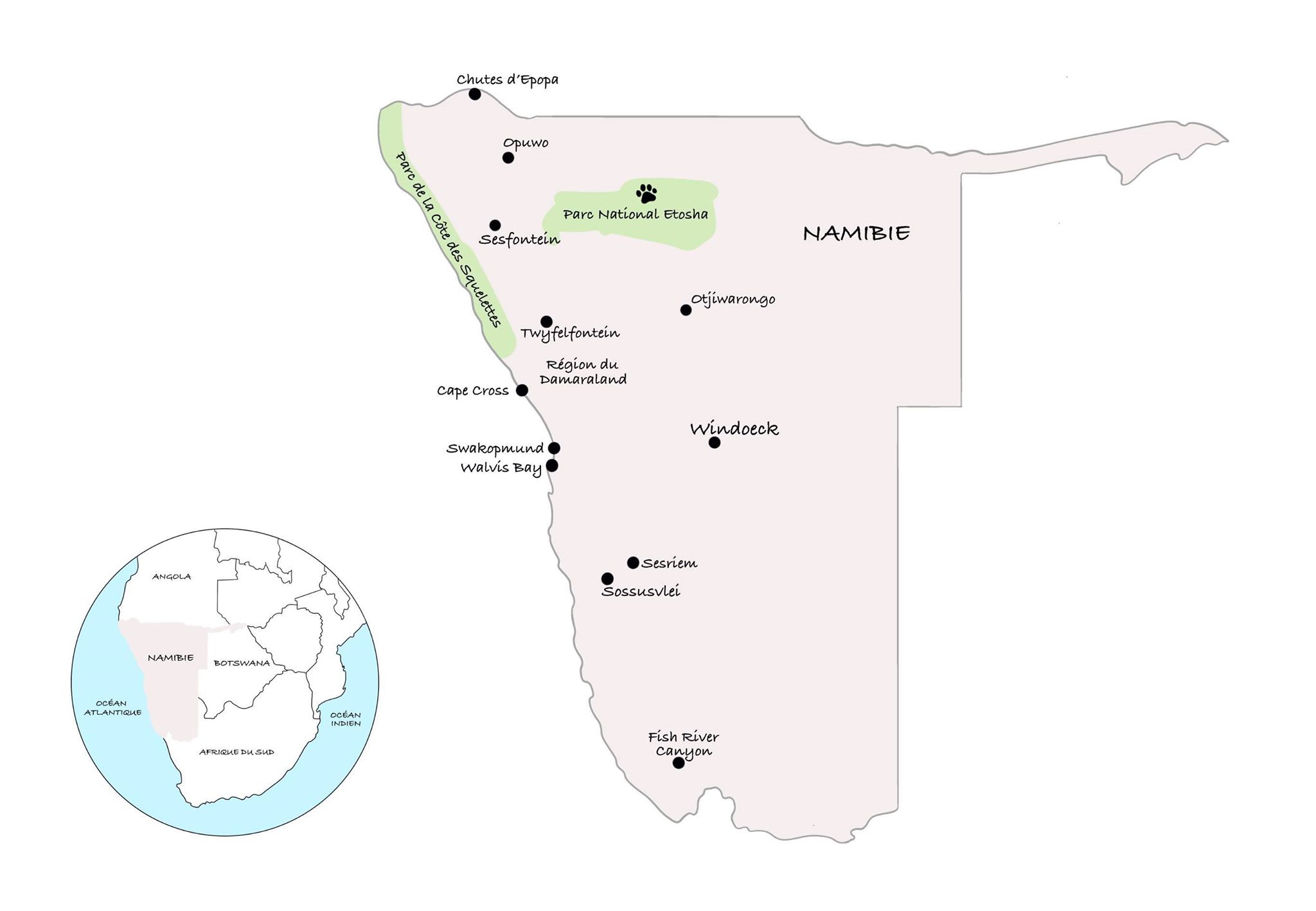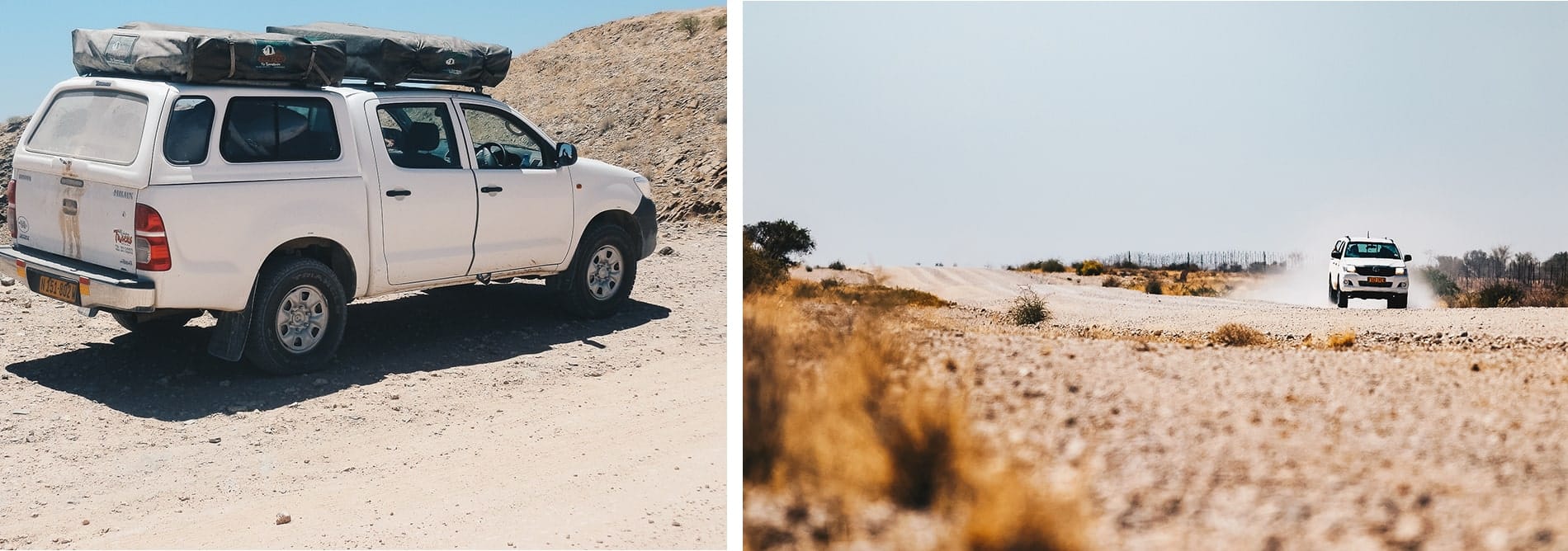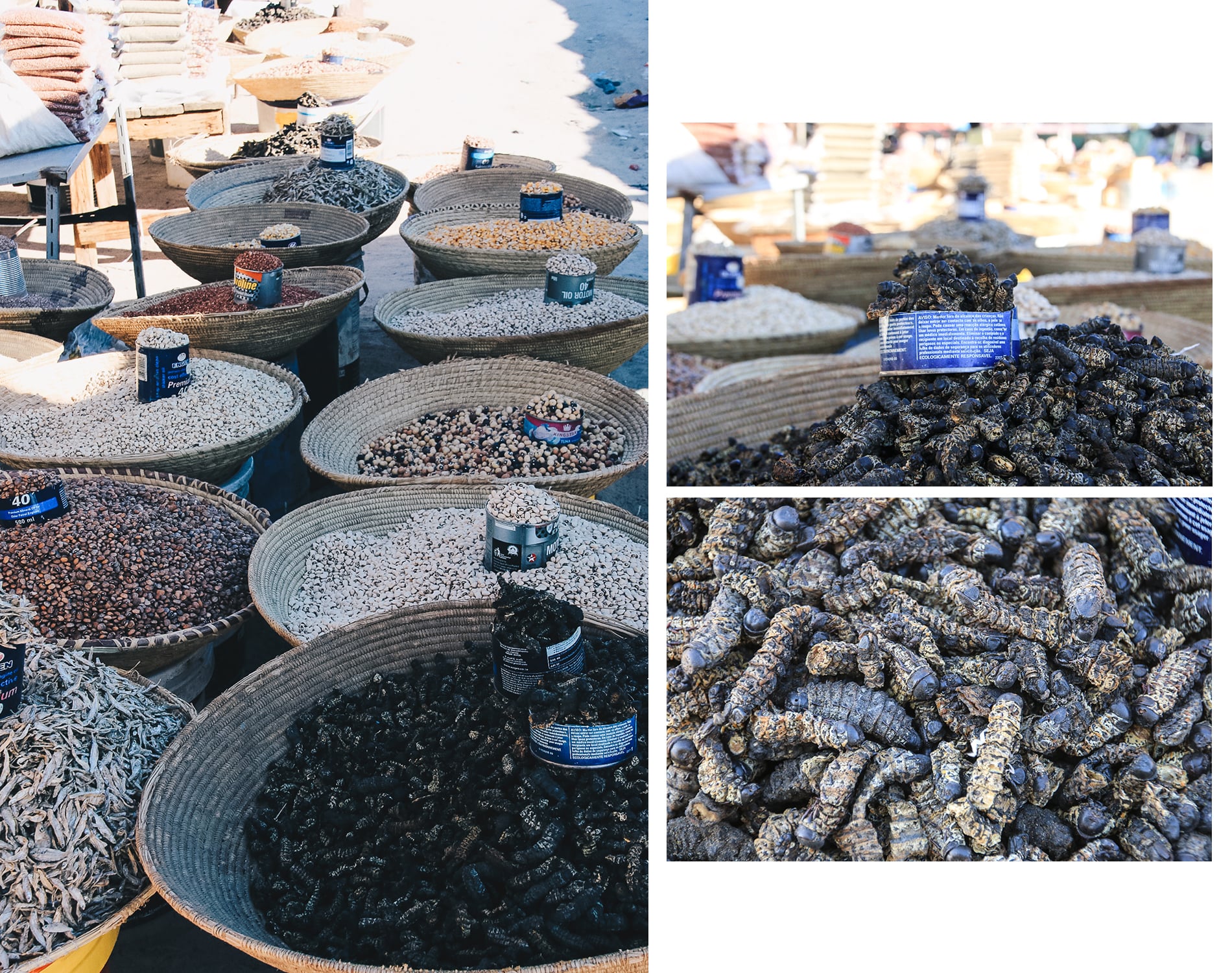
Namibia is an atypical country where untouched nature awaits you. Wide open spaces as far as the eye can see, a rich palette of colors and diverse landscapes, preserved ethnic groups and exceptional wildlife that you can observe in Etosha National Park.
Namibia is a country that will leave you breathless with the beauty of its landscapes, which have inspired numerous films: arid lands, vegetation, animals, sand dunes, red earth, ethnic groups, everything is there to make you dream. The locals are incredibly kind and this country is one of our favorites.
I invite you to consult our articles on Namibia to help you prepare for your trip:
- 7 reasons to visit Namibia
- Where and how to see the Himbas
- Discover the amazing cheetah conservation center
- Our top 10 things to do in Namibia
Leaving the capital Windhoek, we headed north through wildlife reserves, meeting Himbas, Zimbas and Hereros before descending along the west coast to the majestic Sesriem Desert. Here’s an idea for a 17-day itinerary in Namibia, as well as practical information to help you prepare for your trip.
17-DAY ITINERARY
| WindhoekDeparture
| Okonjima: Visit to Okonjima nature reserve and cheetah rehabilitation center
| Otjiwarongo: Visit to a cheetah conservation center
| Etosha National Park:2-day safari
| Himbas: 2 days discovering the Himbas ethnic groups. Visit a school, a village and spend the night in the village.
| Epupa Falls: Sunset over the Epupa waterfalls
| Opuwo: Lodge stopover
| Opuwo – Sesfontein – Hantmann Valley: 4×4 day in breathtaking scenery
| Sesfontein: Encounter with the “Herrero” and “Zimba” tribes
| Twyfelfontein: The petrified forest, back to the Ice Age
| Cape Cross:A colony of 100,000 sea lions
| Swakopmund: Sand board for surfing sand dunes
| Sesriem: Sunrise on Dune 45 and salt desert
| Sossuvlei: Hot-air ballooning over the desert
Back to Windhoek

Thefts
There are no direct flights between France and Namibia. You often make a stopover in Doha, Johannesburg or Cape Town, depending on the airline you choose. There are a few direct flights from Germany, such as Frankfurt and Windhoek with Air Namibia. Allow 15h15 for an average flight time.
Other possible airports are :
- Walvis Bay on the Atlantic coast, near Swakopmund, with flights from Cape Town and Johannesburg Walvis Bay may be an option if you’re combining Namibia with South Africa, or if you just want to spend a few days in the Swakopmund region.
- Victoria Falls in Zimbabwe: Victoria Falls is very close to Namibia, and you can start a trip in Windhoek and end it in Victoria Falls (or vice versa). Please note: this represents a significant additional cost.
To get the best price for your flight, it’s best to book well in advance (at least 6 months). Find your cheapest flight to Namibia here with Skyscanner
Time difference
- + 1h in summer in Windhoek (November to March)
- – 1h in winter (April to end of August)
- No time difference in the first week of April or in September-October.
- Currency: Namibian dollar (NAD).
If you’re transiting through Johannesburg airport, take advantage of the waiting hours to change money or withdraw rands from an ATM: this will save you time on arrival in Windhoek, where exchange offices are not as fast.
There’s no need to take US dollars if you’re staying in Namibia, as the euro is widely accepted.
Visa and MasterCard are accepted. American Express is unknown in Namibia.
Please note, however, that banks are not allowed to sell foreign currency to non-resident foreigners: if you need to go to Zimbabwe afterwards, make sure you have a reserve of US dollars for visa fees
- Spoken languages
English and Afrikkans
- It’s advisable to be up to date with your universal vaccinations before you leave (diphtheria, tetanus, polio, whooping cough, hepatitis A and B). The only vaccination required is against yellow fever.
- Take mosquito protection and malaria treatment at certain times of the year.
- Repatriation and medical expenses insurance
- Avoid drinking tap water.
- Passport valid for at least 6 months from the end of your stay in Namibia, with at least 2 blank pages.
- French nationals do not need a visa to visit Namibia.
The sockets used in Namibia are not the same as those used in France. Take along a universal adapter and a multiple socket for charging all your devices. The voltage is also different in Namibia (220 V), whereas the voltage in France is 230 V. This is not a problem, however, as the equipment is designed to operate in the 200-240V range.
The number of WIFI hotspots in Namibia is normal. It’s relatively easy to find Wi-Fi access at campsites, both in the main rooms and in the Lodges.
Namibia doesn’t offer a very wide range of accommodation, and there are 3 options:
- First option: camping:
Camping is surely the most obvious choice, as it’s also the most economical. Camping means adventure, independence and freedomrté. You’ll find many of these all over the country, most of them well-equipped with decent sanitary facilities, water and electricity points on each pitch and space for cooking. Most people sleep in tents on the roof of their vehicles, and you’ll soon find that this type of accommodation gives you maximum freedom. In secure campsites, you can stand up to go to the toilet. In the more open campsites, watch out for small animals in the evening, such as jackals roaming around your tents. Remember to drink a little less in the evening to avoid getting up, or bring a bottle with you.
When you choose to take a guide for the whole stay, he or she takes care of meals during the day, as well as pitching the tent, so you’re much more at ease and can relax too. Without a guide, you’ll have to do everything yourself.
⚠️ If you’re planning to camp, please note that wild camping is not permitted in Namibia!
- Second option: guesthouses:
There are a few in Windhoek and on the outskirts of the country’s larger towns, but you won’t find many as you head deeper into the country. So you can alternate between campins and guesthouses.
- Third option the Lodges:
Much more comfortable, but also much more expensive, Lodges are priced per person, even if you share a room. The scenery is often very natural, as wide open spaces are always very close by. They are also almost always equipped with a swimming pool and restaurant.
Remember to book your campsites in advance, especially if you go during the high season. Travelling to Namibia only in a lodge requires a certain budget, as in recent years the country has significantly increased its prices to position itself in a more luxury niche, like its neighbor Botswana.
- Namibia doesn’t offer the kind of convenient public transport services you’d find in Asia or South America, with well-developed bus and train networks. In fact, getting around Namibia is quite difficult without a vehicle. You can drive either a Toyota Corolla or a 4×4. It all depends on your itinerary, your budget and what you want to discover. Not all these veicles are suited to the same journey.
- Travelling by 4×4 really gives you that feeling of freedom. This is very practical for safaris, as the 4X4s are higher in the chassis, but beware: 4X4 rental rates rise quickly. Compare the best 4×4 rental rates here.
- An International Driving Permit is theoretically required, otherwise a French driving license with an official English translation.
- Driving in Namibia is not the same as driving in Europe: for one thing drive on the left and secondly there are no freeways and the roads are virtually unsealed.
- Generally speaking, Namibia’s tracks and roads are in good condition. The country has only very few tarmac roads and you’ll be riding mainly on straight roads and tracks. There are areas such as Kaokoland, a rather remote region but also the land of the Himbas, that are difficult to access. A guide is therefore a must, as it’s best to be experienced and to master your 4×4. In fact, you can take dry rivers, cut a road to discover a village, ride on tracks with dozens of big bumps, and of course, there’s no signpost mentioning anything. Please note that not all 4x4s can drive in the sand dunes, and you may have to repair a tire or other technical problem, as happened to us on 2 occasions.
- If you visit the country’s main sites without a 4X4 vehicle, are cautious and don’t take on the few unsuitable tracks, you won’t need a guide. Driving at night is strongly discouraged, so you should always arrive at your campsite in the late afternoon.
In my experience, I’d recommend a trip to Namibia in 4×4 with a guide, so you can get off the beaten track as soon as possible and talk to him about his country, without having to worry about preparing meals, stocking up on food and water and pitching tents. After a few hours on the road and on the trail, early mornings… tiredness builds up and the guide is there to manage it all. He’s also very useful on safari, as he has a flair for communicating with other guides on the whereabouts of the big 5, knows the local areas and won’t be afraid to go deep into the tracks so that you’re alone in the world with these wild animals.

In Namibia, we chose to travel by 4×4 and sleep in rooftop tents at campsites. We also had to stock up on running gear, which we renewed every 3 days or so, as soon as we passed close to a town. It is extremely important to have a good supply of drinking water at this time. You’ll find local beers, South African wines, pulses and vegetables, as well as meat, which plays an important role in the diet. Locals often eat dried, spicy cuts of meat, the famous biltong, as well as barbecued meat. Our guide also gave us a taste of dried insects such as mopani, purchased from an authentic market.
On the lunch menu, picnics and on the evening menu, hot dishes prepared by our guide. Restaurants are also available. They are mainly found in towns or in Lodges that offer this type of service.
Most of Namibia’s ethnic groups prefer mieliepap (or pap), a sticky cornmeal eaten by hand, sometimes accompanied by stewed meats.

Namibia is one of the safest countries in Africa. We always felt safe, except in Swakopmund, where we quickly realized that we shouldn’t hang around too much in certain areas after a certain hour. However, I have heard that more and more South Africans are coming to Namibia to work and earn money, and that crime is becoming more and more common (theft, assault…). Take the usual precautions, so always be careful with your personal belongings in the streets of big cities, and don’t go out at night. You can also limit the risks by avoiding leaving branded items outside the tent.
- Clothing
Namibia is a warm country on the whole. You’ll need light, comfortable clothing, which you won’t want to wear too much on trail expeditions, as you’ll be covered in dust and red earth (especially among the Himbas), sun cream, hat or cap, shorts, tee shirt, walking shoes, binoculars and telephoto lenses for safaris, tee shirts, walking shoes, binoculars and telephoto lenses for safaris, as well as wool and a scarf if you’re going during the austral winter (the nights are cool around the Atlantic coast), and something to refresh you regularly (a water bottle, for example). We almost got caught out, but luckily we had the pants, fleece and windbreaker to shelter us from it all.
- Other
If you’re going to meet ethnic groups, remember to take with you objects for exchange and conversation, or small gifts. We always had photos of our families, our homes, our country and a map of the world to explain who we were and where we came from. It’s a real plus that will facilitate exchanges and help you break the ice more easily.
We brought back some Himbas handicrafts and sand from the dunes. Ethnic groups are also keen to sell you their handmade jewelry or small decorative objects.
The climate in Namibia is subtropical, but you can travel to Namibia in the following ways all year round in this country.
For safaris and animal watching, the the best time is during the dry season and even more so in September-October (at the end of the dry season when the animals gather around the few watering holes). If you’re an avid birdwatcher, and want to witness the great migrations of animals, you’ll love the rainy season.
Temperature-wise, the hot, humid period runs from October/November to March and the country experiences the hottest weather, but the coast remains cool. Between October and December, you’ll experience a warm, dry period, punctuated by scattered light rains. Between January and April, these stormy showers become more intense and more frequent
High season is from June to October. July and August are very popular with both international and South African travellers. In summer, you’ll discover wildlife on clear, warm days, and experience mild nights that aren’t too cold yet.
From May to September, we enter the so-called dry period with cooler temperatures. It’s winter in the southern hemisphere, and the temperature variations are quite considerable: from 0° at night to over 40° during the day. If you want to avoid the heat, this is the best time to do it.
We were there in February, and the climate was warm but pleasant, except around Cape Cross, where we had to endure a few short, irregular showers.
Off-season travel has many advantages:
- You’ll benefit from lower rates than during the high season.
- There are fewer people visiting the country.
- The landscape is even greener, especially in the north of the country. Many photographers prefer this period for the breathtaking colors.

Namibia is becoming an increasingly popular destination for travelers, so it’s essential to plan your trip a few months before you leave.
- Prices have more than doubled in just a few years, and today you can expect to pay at least €5,000/p (sometimes without flights) for a 13 to 15-day trip to Namibia.
- The months of July and August are very popular with both international and South African travellers. Prices are therefore quite high, but the cost of travel remains lower between January and March. To get the best price for your trip, it’s best to book well in advance, at least 6 to 8 months.
- Accommodations must be booked in advance, as demand is high and they are fairly limited (Namibia is still a country spared from mass tourism).
Before you leave, don’t forget to read all our other articles on Namibia to help you prepare for your trip:
- 7 reasons to visit Namibia
- Where and how to see the Himbas
- Discover the amazing cheetah conservation center
- Our top 10 things to do in Namibia
Please note that as an accredited bespoke travel designer, I offer to accompany you in the creation of your tailor-made trip to Namibia and create a personalized itinerary tailored to your needs. Please send me an email at : contact@mademoiselle-voyage.fr
